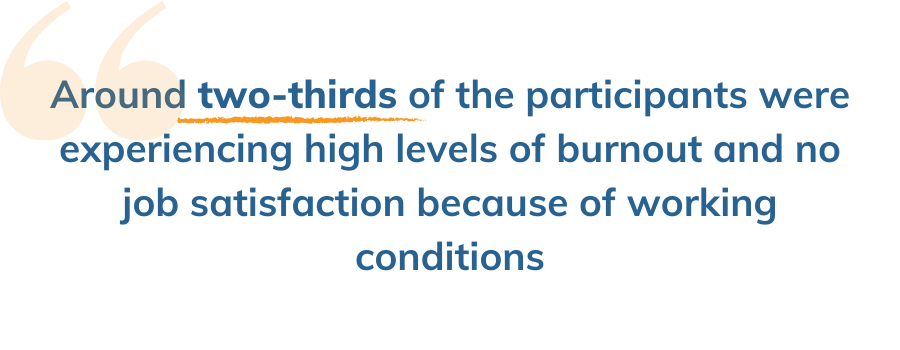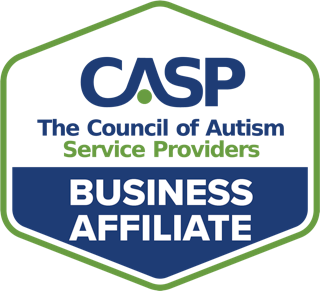Applied Behavior Analysis (ABA) Therapy practices are constantly struggling with employee turnover, and it is an enormous cost to the business. The reality of this problem has created an increased interest in ways to reduce Board Certified Behavior Analyst (BCBA)/Registered Behavior Technician (RBT) turnover & retention. This blog post will provide information on effective strategies for reducing staff turnover and general tips for retaining employees within ABA Therapy practices.
The Correlation Between Employee Turnover and Getting Burned Out
Why Does Employee Turnover Exist within ABA Therapy Practices?
The high-stress nature of working at an ABA Therapy practice for parents whose kids may not communicate well has its share of challenges. It is important for ABA Therapy practices to reduce turnover within their BCBAs and RBTs in order to:
- Maintain a positive work culture
- Avoid the costs of recruitment
- Minimize the costs of training new employees
- Optimize the use of equipment by reducing staff transition periods
- Reduce stress on parents by having familiar faces work with their children
- Reduce stress on the kids receiving ABA therapy services by remaining consistent with their BCBAs and RBTs
How Do I Know If My Employee(s) Are Getting Burned Out?
Here are some common signs that your employees might be burning out:
- Increased errors and omissions on their part during work activities
- Absences from work without notice
- Frequent complaints about feeling overwhelmed by responsibilities with no end in sight for increasing demands at work
- Unwillingness to engage socially outside of work
- Lack of enthusiasm for new initiatives or projects
- Increased cynicism, criticism, and apathy toward company policies or procedures
- Decreased motivation to engage in work activities and/or loss of interest in tasks
Why Does ABA Therapy Have Such a High Turnover Rate?
The answer to this question is complex, but the primary cause of BCBA/RBT turnover in ABA Therapy practices can be attributed to the same as most industries. The employee feels they are under-compensated. However, in a field that requires extensive education and experience, it is often difficult for individuals with these qualifications to feel in control of their finances, as they likely have great student debt.
On top of daily financial woes, employees who feel overworked, underappreciated, and unfulfilled, while simultaneously feeling they are underpaid, tend not to see their position as sustainable long term. While business owners and managers may not compensate as much as employees would like, they can provide the best working environment possible.
Turnover hurts everyone involved, so it’s important to do all one can to prevent it. Here are just some of the negative effects.
- Management loses time and resources while training new staff members.
- Clients miss out because there isn’t enough staff on hand to cover all scheduled sessions or provide adequate one-on-one instruction.
- Prospective BCBAs and RBTs are going to start a job with a negative perception of the industry or your workplace, in particular.
How Can I Reduce Turnover?
Hiring and Keeping the Right Talent
The most effective way to reduce staff turnover within ABA Therapy practices is by improving your hiring and retention process with thorough interviews/reviews and listening more closely when concerns and goals are expressed. Use this time to not only evaluate your employee, but your own company, and whether you can meet their expectations.
As well as avoiding employee burnout, these strategies will help you bring on and keep individuals whose values align with yours. It will also provide them the support they need so they feel fulfilled at work and committed long-term.
Finally, hire and keep employees based on their skills and personality, instead of focusing solely on availability and affordability to reduce turnover. Finding and retaining individuals whose values align with yours is paramount to long-term success.
Be Flexible
An excellent way for companies in this field to reduce employee turnover is by offering flexible scheduling options such as part-time hours or remote work arrangements, when possible. This will reduce the burnout that often leads to employee turnover.
We live in a different world than we did prior to the COVID-19 pandemic, and people expect more leeway in when and how they work. Don’t treat that as a negative. Take advantage of the flexibility you can afford to be more appealing.
Reduce ABA Therapy staff turnover by first making sure you understand why employees are quitting and then make targeted changes, so individuals feel fulfilled in their roles. Businesses that remain stagnant will continue to have the same problems over time.
Contributing Factors to BCBA Burnout
A study showed that around two-thirds of the participants were experiencing high levels of burnout and no job satisfaction because of working conditions.
Employees report working an average 12 hour day, which significantly increases stress levels while decreasing job satisfaction – another factor leading to employee turnover. In addition, staff members have reported the following contributing to burnout:
- Feeling isolated from colleagues or management within institutions.
- A lack of transparency around policies such as PTO.
- Lack of training.
- High turnover within the workplace.
However, according to recent studies published in Behavior Analysis, you can help reduce employee burnout by identifying ways BCBAs/RBTs can make meaningful contributions during their workday, which allows them to experience success daily while increasing loyalty and retention.
If you’re looking for help on reducing BCBA burnout, contact us today.
How to Battle the Burnout BCBAs are Experiencing
Applied Behavior Analysis companies can reduce burnout in the ABA Therapy field by first understanding why employees are quitting. First, it’s important to note that while BCBAs/RBTs might leave for higher-paying jobs elsewhere, many report leaving because they feel underpaid and overworked without appropriate support systems or opportunities for career advancement.
This can be fixed by adjusting processes. A qualified Director of Operations should be able to significantly change attitudes by changing organizational charts, job descriptions, etc., so some major issues are eliminated.
Finally, encourage growth within the company through cross-training opportunities, so employees don’t feel they are stuck in one role for years on end without learning anything new.
How to Reduce Turnover and Improve Retention
Set Clear Expectations
The first step in reducing your employees’ turnover is to set clear expectations with your new employees. A good way of doing this is through a mission statement, which should be specific and measurable. For example, ‘providing quality service’ or ‘delivering effective therapy’ are both vague statements that do not provide any direction for how they will be accomplished. Avoid phrases such as those.
Explain the mission statement you have established with your team members, as well as any policies that are specifically related to their position on staff, such as attendance policy, guidelines around phone etiquette, etc.
In addition, allow employees time during work hours to read over documents regarding patient care protocols and discuss them with colleagues before beginning therapy sessions at home/in-school settings with children who require ABA services. This way, they will be confident and likely more pleased with the outcome of their therapy session.
Improve Onboarding and Training
Improve onboarding and training to reduce staff turnover. This will help their experience long term and improve the general culture for BCBAs/RBTs, making them feel more fulfilled in their roles. Reducing turnover is easier than you think!
Assess
The first step to reducing staff turnover is by thoroughly assessing your current system and identifying areas that could be improved upon. Although this may take some time initially, it’s an important step towards building a healthy company where employees feel valued and satisfied with life both inside and outside of work.
If you don’t provide adequate training for new hires, including a thorough orientation program that lays out expectations upfront, work on fixing this right away. This way there’s no confusion about how they should do their job from day one.
Create Goals
In order to get where you want to be, one must set goals. Having concrete, achievable business objectives that align with their employees’ personal interests will keep them interested in their positions longer than if they feel like their work doesn’t make a difference or is not important at all.
Give employees more responsibility and autonomy by encouraging them to give input on how they can best help your company meet its objectives. At the same time, establishing goals for all staff members when it comes to patient care can reduce frustration among therapists who might feel as though their work isn’t valued by management if they have established no end goal for them to strive toward each day.
By setting weekly meetings with supervisors where the therapist’s progress can be discussed, they will inform everyone about what needs to be done, and what is being achieved or not achieved in terms of goals.
However, the most effective goals you can set to reduce retention rates would be increasing job satisfaction, decreasing overworked staff members, offering appropriate bonuses/compensation packages, and promoting an environment where people are appreciated and listened to.
Make sure you have the proper infrastructure to reduce employee turnover rates by choosing an ABA therapy practice management system that is easy for staff members to learn and use.
Focus on Employee Benefits
Since we know salary is often something people are unhappy with, focus on employee benefits (health insurance, retirement plans, and wellness programs) and reduce job dissatisfaction by adding incentives for staff members who participate in activities such as meditation or yoga, which reduce burnout rates overall!
Training Programs
Finally, consider adding training programs or a cross-training program to your ABA therapy company’s list of available benefits where employees can learn additional skills to help them grow within their positions. This will reduce boredom associated with limited roles at one location, while also increasing satisfaction and reducing turnover rates among BCBAs/RBTs.
Resources that RethinkCare offers help reduce staff turnover rates among BCBAs/RBTs through ongoing training opportunities where employees feel fulfilled within the role they’ve been hired into.
Leadership and Management
What do leadership and management have to do with reducing turnover in ABA therapy companies?
First, leadership and management are key to reducing staff turnover within Applied Behavior Analysis companies by showing employees they’re valued not just through financial incentives, but also through the creation of a positive work culture where BCBAs/RBTs feel fulfilled both inside and outside of their role!
Creating this type of environment will reduce burnout rates among BCBAs/RBTs, leading them to stay at your company long term.
Peers
Peer support is a great way to reduce turnover rates among BCBAs/RBTs because it allows staff to share their successes and challenges with one another, which reduces burnout associated with a lack of inside perspective within Applied Behavior Analysis companies.
You can also help ABA therapists feel supported by creating new ideas for challenging behavioral goals, or assisting in finding solutions when therapists face an individual that is difficult.
Engagement
Creating an open culture where BCBAs/RBTs feel valued and heard seriously reduces job dissatisfaction. Listening is key in any relationship!
Creating these types of environments reduces burnout levels that lead to increased employee attrition over time, while fostering a positive work environment for all staff members by reducing internal stress associated with long hours spent working on challenging ABA therapy cases.
What Are You Waiting For?
You likely have many items you need to work on based on reading this blog post, and perhaps even some more questions. Reach out to us and we’ll be happy to dive deeper into this topic with you.
If you found this blog post on Ways to Reduce BCBA/RBT Turnover & Retention informative, please share with other friends in the industry looking for ways to reduce staff turnover!
















